Glaucoma
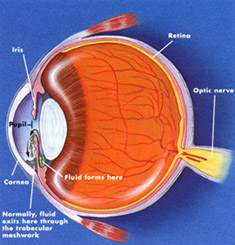 Glaucoma is a disease of the optic nerve (the part of the eye that carries the images we see to the brain.) When damage to the optic nerve fibers occurs, blind spots develop. Theses blind spots usually go undetected until the optic nerve is severely damaged. In extreme cases, if the entire nerve is destroyed, blindness results.
Glaucoma is a disease of the optic nerve (the part of the eye that carries the images we see to the brain.) When damage to the optic nerve fibers occurs, blind spots develop. Theses blind spots usually go undetected until the optic nerve is severely damaged. In extreme cases, if the entire nerve is destroyed, blindness results.
Glaucoma is the leading cause of blindness in America, but loss of sight from Glaucoma can often be prevented with early treatment and yearly eye exams by an eye care professional.
Return to TopCataracts
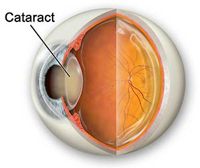 A cataract is a clouding of the normally clear lens of the eye. It can be compared to a window that is frosted or yellowed. The most common type of cataract is related to aging of the eye. An eye care professional can detect the presence of a cataract at a yearly eye exam. The most common form of treatment is surgery, and is the only way a cataract can be removed. Surgery is not necessary in all cases, sometimes a simple change in your eyeglass prescription may help.
A cataract is a clouding of the normally clear lens of the eye. It can be compared to a window that is frosted or yellowed. The most common type of cataract is related to aging of the eye. An eye care professional can detect the presence of a cataract at a yearly eye exam. The most common form of treatment is surgery, and is the only way a cataract can be removed. Surgery is not necessary in all cases, sometimes a simple change in your eyeglass prescription may help.
Diabetic Retinopathy
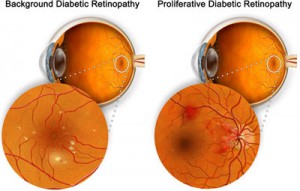 High blood sugar levels, most common in people who have diabetes, can damage blood vessels in the retina (the nerve layer at the back of the eye that senses light and helps to send images to the brain.) This damage is known as Diabetic Retinopathy.
High blood sugar levels, most common in people who have diabetes, can damage blood vessels in the retina (the nerve layer at the back of the eye that senses light and helps to send images to the brain.) This damage is known as Diabetic Retinopathy.
There are two types of diabetic retinopathy – nonproliferative (NPDR) and proliferative (PDR.) Many people with diabetes have mild NPDR that usually does not affect their vision. NPDR is an early stage of diabetic retinopathy, when blood vessels within the retina leak blood or fluid. PDR is when abnormal new vessels begin growing on the surface of the retina or optic nerve. These new vessels are often accompanied with scar tissue that may cause wrinkling or detachment of the retina.
People with diabetes should schedule a regular eye exam at least once a year to detect any changes inside the eye, and to prevent the development of retinopathy as much as possible. Strict control of blood sugar levels will significantly reduce the long-term risk of vision loss.
Return to TopMacular Degeneration
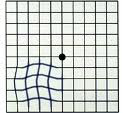 Macular Degeneration is a deterioration or breakdown of the macula (the small area in the retina at the back of the see that allows you to see fine details clearing.) When the macula does not work properly, central vision can be affected by blurriness, dark areas or distortion.
Macular Degeneration is a deterioration or breakdown of the macula (the small area in the retina at the back of the see that allows you to see fine details clearing.) When the macula does not work properly, central vision can be affected by blurriness, dark areas or distortion.
Many older people develop macular degeneration as part of the ageing process. The most common is age-related macular degeneration or AMD. Here are some common ways vision loss can be detected:
- Words on a page look blurred;
- A dark or empty area appears in the center of vision and;
- Straight lines look distorted, as in the following diagram
Your eye care professional can detect early stages of AMG during a yearly eye exam, so schedule your appointment today.
Return to TopFloaters and Flashes
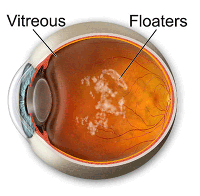 Do you sometimes see small specks or clouds moving through your field of vision? These are called Floaters. Floaters are tiny clumps of gel or cells inside the vitreous (the clear gel-like fluid that fills the inside of the eye.) While these objects look like they are in front of the eye, they are actually floating inside. What you see are shadows they cast on the retina.
Do you sometimes see small specks or clouds moving through your field of vision? These are called Floaters. Floaters are tiny clumps of gel or cells inside the vitreous (the clear gel-like fluid that fills the inside of the eye.) While these objects look like they are in front of the eye, they are actually floating inside. What you see are shadows they cast on the retina.
As people reach middle age, the vitreous gel may start to thicken or shrink, forming clumps or strands inside the eye. The vitreous gel pulls away from the back wall of the eye, which is a common cause of floaters. Most floaters are harmless and fade over time or become less bothersome, requiring no treatment. Although you may have had floaters for years, you should still schedule an eye exam with an eye care professional as some new floaters and sudden flashes of light may be signs of a more serious problem.
Return to TopDry Eye
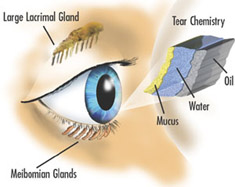 Dry eye accurs when your eye does not produce enough tears or the appropariate quality of tears to keep the eye healthy and comfortable. The usual symptoms of dry eye include;
Dry eye accurs when your eye does not produce enough tears or the appropariate quality of tears to keep the eye healthy and comfortable. The usual symptoms of dry eye include;
- Stinging or burning eyes;
- Scratchiness;
- Stringy mucus in or around the eyes;
- Excessive eye irritation from smoke or wind;
- Excess tearing and;
- Discomfort when wearing contact lenses.
A eye care professional either through a routine eye exam or tests that measure tear production can diagnose dry eye. The most common treatment for dry eye are eyedrops (artificial tears) that are used to lubricate the eyes and help maintain moisture. Other methods are available and can be suggested by an eye care professional.
Return to Top
